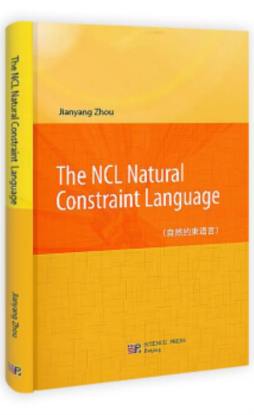自然约束语言
出版社:科学出版社
年代:2011
定价:80.0
书籍简介:
《自然约束语言NCL : 简明教程》可为在高等学校和科研院所中学习研究运筹学、应用数学、人工智能、工业工程、物流优化和计算机科学等的老师和学生提供指导教材。一方面,本书着重介绍自然约束语言NCL(Natural Constraint Language)的理论基础--混合集合规划与自然建模;另一方面,本书详细介绍使用NCL语言的开发平台——POEM(Programmingin Operational and Expressive Models)对组合优化问题的求解方法。组合优化问题在我们日常生活和工作中广泛存在,而且因为往往是NP-hard的,所以一般来说难以求解。设计POEM的目的就是为程序师提供一个建模和求解大规模组合优化问题的编程环境。作为POEM内核的NCL语言,是一门以标准的数理逻辑为语法的运筹学的自然语言。在此意义上,NCL是新一代的计算机语言:与一些经典的声明型语言和脚本型建模语言不同,NCL是上下文相关的智能描述型语言,可以自动对上下文进行语法与语义分析,将标准的数理逻辑表达式智能地匹配到NCL的运筹学算法库中相应的算法。亦即,NCL可以根据程序的上下文智能的推理和求解。本书结构共分四章,第一章对运筹学软件POEM进行概要介绍;第二章也是本书的核心,介绍了计算机自然约束语言NCL设计的基本体系和掌握的原理方法,内容包括词汇、数据类型、语法及参数配置等;第三章对运筹学软件POEM平台的使用方法做了指导性说明;最后一章阐述了运用NCL语言进行数学建模与求解的方法,其中还包含了基础建模方法和难题建模的方法,最后配有难题求解案例和解答。
书籍目录:
1 Introduction
1.1 Modeling and Solving
1.1.1 Programming Framework and Algorithm
1.1.2 Formal Grammar and Parser
1.2 The NCL Language
1.2.1 Natural Modeling in Mathematical Logic
1.2.2 Cooperative Solving
1.2.3 Comparison with Some Other Systems
1.3 The POEM Platform
1.3.1 Development Toolkit
1.3.2 Component and Server
References
2 Data Types and Lexical Conventions
2.1 Data Types
2.1.1 Generality
2.1.2 Set
2.1.3 Date/Time
2.1.4 Numeric
2.2 Lexical Tokens
2.2.1 Characters
2.2.2 Identifiers
2.2.3 Predefined Identifiers
2.2.4 Constants
2.2.5 Non-Instantiated Values
2.2.6 Comments
2.3 Mathematical Notations
2.3.1 Mathematical Symbols
2.3.2 Predefined Functions
2.3.3 Delimiters of TeX
References
3 Grammar and Semantics
3.1 Context-Free Rules
3.1.1 Overall Structure
3.1.2 Expression
3.1.3 Constraint
3.1.4 Declaration
3.1.5 Declarative Control
3.1.6 Temporal Control
3.1.7 Search and Optimization
3.2 Context-Sensitivity of NCL
3.2.1 Constant
3.2.2 Variable
3.2.3 Function
3.2.4 Sub-Model
References
4 Tutorial Programs
4.1 Getting Started
4.1.1 Input and Output
4.1.2 Default Value
4.1.3 Data Buffer
4.2 Boolean Logic
4.3 Numerical Reasoning
4.3.1 Integer Equation
4.3.2 Infinity
4.4 Date/Time
4.5 String
4.5.1 String Input
4.5.2 Concatenation
4.6 Referencing
4.6.1 Reference in a Subscript
4.6.2 Referenced Operator
4.6.3 Subscript Leak
4.7 Set Reasoning
4.7.1 A General Example
4.7.2 Attributes of a Set
4.7.3 Piecewise Intervals from a Set
4.8 Special Variable
4.8.1 Anonymous Variable
4.8.2 System Variable
4.9 Predefined Function
4.9.1 Float Function
4.9.2 Aggregate Function
4.9.3 Transformation
4.9.4 Substring
4.9.5 Elements of a Set
4.9.6 Date/Time Attribute
4.9.7 Extraction
4.9.8 Assignment
4.10 User-Defined Function
4.10.1 Cotangent
4.10.2 Global Variable in a Function
4.10.3 Query and Objective in a Function
4.10.4 Predicate
4.10.5 Recursive Function
4.10.6 Termination of a Recursion
4.10.7 Tree
4.11 Selection Statement
4.11.1 Switch
4.11.2 If-Then-Else
4.12 Quantification
4.12.1 Existential Quantification
4.12.2 Universal Quantification
4.13 Jump
4.13.1 Exit from a Universally Quantified Statement
4.13.2 Exit from an Infinite Loop
4.14 Query and Search
4.14.1 Approximate Solution
4.14.2 Search over a Float Domain
4.15 Optimization Objective
4.15.1 Single-Objective Optimization
4.15.2 Multiple-Objective Optimization
4.16 Custom Message
4.17 Soft Constraint
4.18 Sub-Model
4.18.1 Sub-Model in a File
4.18.2 Sub-Model in a Buffer
4.18.3 Return Values of a Sub-Model
4.18.4 Recursive Sub-Model
4.18.5 Overflow in Calling a Sub-Model
4.19 SQL Query
4.20 OS Command
4.21 Expectation and Debugging
5 The POEM Software Platform
5.1 Main Interface
5.1.1 Tool Bar
5.1.2 TeX Bar
5.1.3 Workspace
5.1.4 Edit Window
5.1.5 Trace Window
5.2 Configuration of a Project
5.2.1 Data Pools for a Project
5.2.2 NCL Parameters
5.2.3 Project Settings
5.3 Model Management
5.3.1 Model Folder
5.3.2 Model Library
5.4 Information Tables
5.4.1 Running Models
5.4.2 Constants
5.4.3 Variables
5.4.4 Constraints
5.5 Visualization and Debugging
5.5.1 Quick Watch
5.5.2 Browser
5.5.3 Constraint Debugger
5.5.4 Visual Debugger
5.5.5 Solution Viewer
5.6 Trace Window and Working Modes
5.6.1 Debug Mode
5.6.2 Timer Mode
5.6.3 Trace Level
5.6.4 Options for Diagnosis
5.6.5 Options for Statistics
5.6.6 Recommended Diagnosis Mode
5.6.7 Recommended Working Mode
5.7 Message Management
5.7.1 Message Levels
5.7.2 Message Types
5.7.3 Message Codes
5.7.4 Message Handler
5.7.5 Termination Status
5.8 Help on Line
5.9 Component and Server
6 Modeling and Solving
6.1 Development Principles
6.1.1 Generality
6.1.2 Data Modeling
6.1.3 Modeling Constraints and Objectives
6.1.4 Modeling Queries
6.1.5 Test and Benchmarking
6.1.6 Diagnosing a Model
6.2 Modeling Abstraction
6.2.1 Distinct Integers
6.2.2 Disjoint Sets
6.2.3 Sorting
6.2.4 Set Covering
6.2.5 Packing
6.2.6 Sum
6.2.7 Cumulation
6.3 Solving Puzzles
6.3.1 Send More Money
6.3.2 Primes
6.3.3 Integer Sorting
6.3.4 Queens
6.3.5 Magic Square
6.3.6 Sudoku
6.3.7 Magic Sequence
6.3.8 Einstein?s Quiz
6.3.9 Calculs d?Enfer
6.3.10 Square Packing
6.3.11 Knight
6.4 Solving Hard Problems
6.4.1 Set Partitioning
6.4.2 Golf Tournament
6.4.3 Progressive Party
6.4.4 Ship Loading
6.4.5 Job-Shop Scheduling
6.4.6 Minimizing the Cost of a Heat Exchanger
6.4.7 Pick-up and Delivery
6.4.8 Exercises
References
7 Industrial Applications
7.1 Complexity of Industrial Problems
7.2 Production Scheduling
7.2.1 Problem Definition
7.2.2 Data Model
7.2.3 Simplified Optimization Model
7.2.4 Visualizing Time: Gantt Chart
7.2.5 Questions
7.3 Personnel Planning
7.3.1 Problem Definition
7.3.2 Data Model
7.3.3 Simplified Optimization Model
7.3.4 Visualizing Statistics: Histogram
7.3.5 Questions
7.4 Multi-Modal Transportation Planning
7.4.1 Problem Definition
7.4.2 Data Model
7.4.3 Simplified Optimization Model
7.4.4 Visualizing Geographical Information: Map
7.4.5 Questions
References
8 Relaxation and Decomposition
8.1 Local Optimization by Relaxation
8.1.1 Relaxation and Interaction
8.1.2 Local Optimization
8.1.3 Iterative Optimization for TSP
8.2 Solving by Decomposition
8.2.1 Solving by Model Decomposition
8.2.2 Model Decomposition for Vehicle Routing
8.2.3 Solving by Data Decomposition
8.2.4 Data Decomposition for Production Scheduling
References
Appendix 1 The Grammar in TeX
Overall Structure
Declaration
Explicit Typing
Function Definition
Label
Elementary Statement
Constraint
Assignment
Optimization Objective
Query and Search
Enumeration Mode
Query Criterion
Output
Data Format
Expectation
Control
Compound Statement
Grouped Statement
Included File
Soft Statement
Custom Message
Selection
Switch
If-Then-Else
Quantification
Existential Quantification
Universal Quantification
Indexing
Jump
Data Connection
Expression
Boolean
Float
Integer
Date/Time
String
Grouped String
Concatenation
Reference
Set
Constant
Variable
System Variable
Input
Extraction
Function
Data Pool
Sub-Model
SQL Query
OS Command
Appendix 2 The ComPoem Component
Description
Properties
Functions
Events
Index
内容摘要:
The NCL Natural Constraint Language presents the NCL Language which is a description language in conventional mathematical logic for modeling and solving constraint satisfaction problems.NCL differs from other declarative languages:It models problems naturally in a simplified form of first-order logic with quantifiers,Boolean logic,numeric constraints,set operations and logical functions;it solves problems by mixed set programming over the mixed domain of real numbers,integers,Booleans,dates/times,references,and in particular sets.The book uses plenty of examples and tutorials to illustrate NCL and its applications.It is intended for researchers and developers in the fields of logic programming,constraint programming,optimization,modeling,operations research and artificial intelligence,who will learn from a new programming language and theoretical foundations for industrial applications.
Dr.Jianyang Zhou is the inventor of NCL and has worked for its industrialization for more than 10 years.
